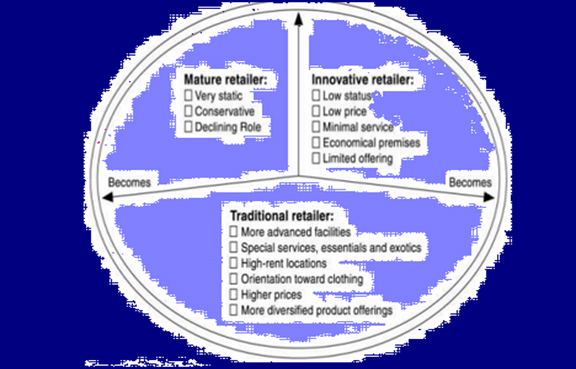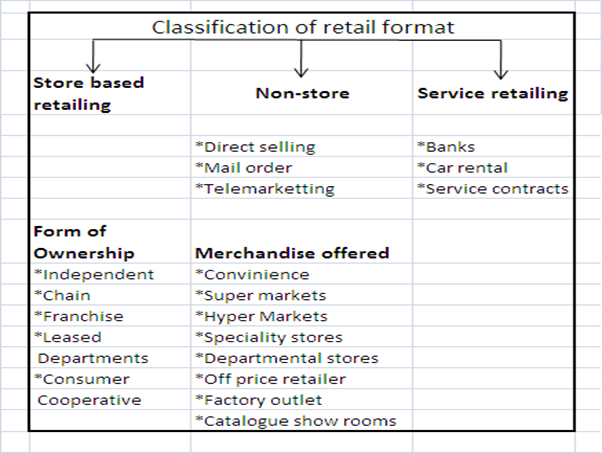Retail Management(Marketing Management)
Retailing is practiced by business persons since ancient times. In any set-up, retailing involves the sale of goods and services to the final consumer (Bennett, 1995). The forms of retailing are bricks-and-mortar stores, non-store bases (i.e., direct retailing), or a combination of a store and a non-store base. The assortment of goods in these businesses is planned, purchased, and presented by the retailer for the convenience of the consumer. The theoretical studies contains information about the fundamental retail institution types and the multi sectioned information about retail evolution, including theories, examples, and problems. Retail basically comprises of selling products or merchandise from a permanent place, such as a department store, boutique or stall, or by mail, in small or individual lots for direct utilization by the customer. Retailing may incorporate secondary services, such as delivery. Buyers may be individuals or businesses. In business, a "retailer" purchases goods or products in huge quantities from manufacturers or importers, either directly or through a trader, and then sells smaller quantities to the shopper. It involves a direct communication with the purchaser and coordinating business activities from designing of a product to its delivery and post-delivery services. Professionals who have skills in retail management are usually recognized as Retail Managers. A Retail Manager is expected to deal with consumers' problems, check retail orders, handle merchandising, control human resource and also oversee the stocks/inventory and supply chain management.
Retail establishments are often known as shops or stores. Retailers are at the end of the supply chain. Manufacturing marketers observe the process of retailing as an essential part of their overall allocation strategy. The phrase "retailer" is also applied where a service provider services the needs of a huge number of individuals, such as a public utility, like electric power. Shops may be on residential streets, shopping streets with few or no houses or in a shopping mall. Shopping streets may be for pedestrians only. Sometimes a shopping street has a partial or full roof to protect customers from precipitation. Online retailing is also common in current business environment. It is a type of electronic commerce used for business-to-consumer (B2C) transactions and mail order, are forms of non-shop retailing.
Retail institution types differ based on retail features such as products, scale of operation, and mix of store attributes. The main retail institution types are department store, discount store, and specialty store. The U.S. Bureau of Census classifications of product developed in1924 stated that product categories were named based on the retail institution type where they were displayed and sold (McNair and May, 1978).
Theories of Retail Management
The development of retail formats at international level has been mostly influenced by a continually hanging social and economic landscape. The main reason for retail stores growth in present scenario is customer's huge demands about products and services. Retail development can be analysed from the theoretical perspective. There is no single theory applicable or acceptable in the area of retail management. The application of each theory differs from market to market, depending on the level of maturity and the socio-economic conditions in that market. Most tasks involved with operating a retail business is the same. However, small or autonomous retail stores may merge many sectors together under one division, while big stores create various divisions for each particular function along with many layers of management.
The theoretical studies in retail management field describe the process of retail development turn around the importance of competitive pressure, the investments in organizational capabilities and the creation of a sustainable competitive advantage. This requires the execution of strategic panning by retail organizations. Expansion in retail is outcome of understanding market signals and responding to the opportunities that occur in a vibrant manner. Theories of retail development can categorised as follows:
- Environmental:
Where a change in retail is recognized to the change in the environment in which the retailers operate. Darwin's natural selection has been popularised by the phrase "survival the fittest". Retail institutions are monetary body and retailers deal with an environment which is made up of customers, competitors and changing technology. This environment can change the productivity of a single retail state as well as of clusters and centres. The environment that a retailer competes in is adequately robust to compress any retail form that does not adjust. Thus, the origin, success or decline of different forms of retail enterprises is many times attributed to the business environment.
- Cyclical:
Cyclical theory fundamentally describes the different phases in a company. This theory states that change follows a pattern and all phases have specific attributes linked with them. There are three primary components in this theory: wheel of retailing, retail life cycle and retail accordion. Wheel of retailing described by McNair II, helps us understand retail changes. It refers to a company entering the market with low prices and reasonable service in order to challenge competitors. Retail life cycle addresses the four stages that a company goes through when entering the buyer's market. This theory proposes that retail innovators often first appear as low-price operators with a low-cost structure and low profit-margin requirements, offering some real advantages, such as specific merchandise, which facilitates them to take customers away from more established competitors. As they grow, they develop their businesses, offering a greater range or acquiring more expensive facilities, but this can mean that they lose the focus that was so important when they entered the market. Such 'trading up' occurs as the retailer becomes established in his own right.
Retail Accordion theory is evolved by Hollander (1966) which explained retail evolution as a cyclical trend in terms of the number of merchandise categories such as product assortment. In this theory, at the beginning of operation, a retail institution carries a broad collection of merchandise such as various types of products or product classifications but does not carry a deep assortment such as various styles within one product classification. The retail accordion aspect of cyclical theory suggests that some businesses go from outlets that offer an array of products to establishments providing a narrow selection of goods and services. These establishments later return to a generalized outlet store. Retail accordion is also recognized as general-specific general theory. At initial stage, the retail institution is a general store. With time, the retail institution becomes specialized by carrying a limited line of merchandise with a deep assortment. Stern and El-Ansary (1977) suggested a graphic model of Retail Accordion theory with breadth of merchandise line assortment changing across time.

Conflict Theory: Numerous researcher studies the various aspects of a Conflict theory to explain retail evolution (Berens, 1980). Gist (1968) suggested the Dialectic theory, influential Conflict theory that has been the basis for the common concepts of many conflict theories. The Dialectic theory is based on Karl Marx's Theory of Evolution. Blake (1939) summarized the Theory of Evolution as the " the progress of change means that everything must decline to make way for new things, that nothing in nature or society is "fixed" or "sacred" since it must share the process of transformation. Dialectics means, specifically, that the phases of each development repeat former phases, but on a different plane. That is, each step is the negation of the previous step, and the next step must be a negation of that negation. It does not restore the original situation, but invariably creates a third situation, which is different because of the double process of negation" (p. 639 - 640). Gist (1968) reinstated the "situation" from the Theory of Evolution with a "retail institution" in the Dialectic theory. He proposed that an existing retail institution is challenged by its competitor because it has competitive advantages over the existing retail institution (i.e., thesis1). As time passes, the first retail institution imitates the characteristics of competitor to upgrade its existing characteristics and finally creates a new retail institution.
Some researchers have attempted to combine two or more evolution theories to explain retail evolution. Some researchers have tried to combine Cyclical theory with either Environmental or Conflict theory (eDeiderick & Dodge, 1983).
Critical success factor in retailing is competition, trends in market positioning and organizational capabilities.
Classification of retail format:
To summarise, retailing is activity of selling products and services to end users. It is related with getting goods in final shape. It is increasing at global level. Retailing greatly impacts the lives of consumers as they all purchase products with different level of enthusiasm. Retail management is significant for success of organization. It requires skill set of employees.

